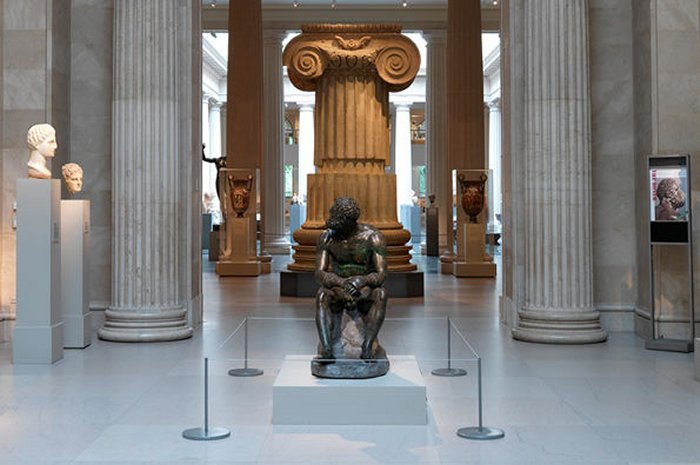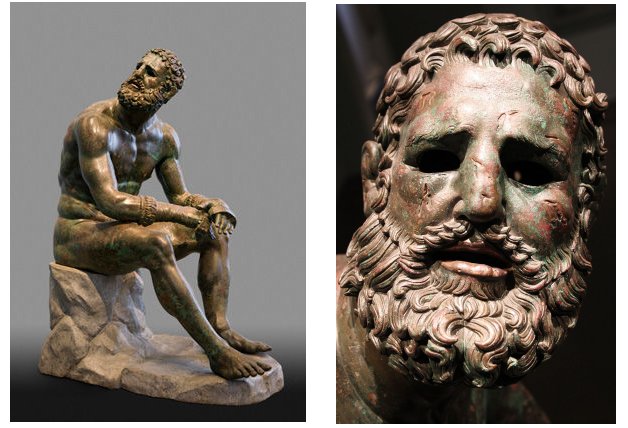Boxer At Rest – Rare Sculpture And Masterpiece Of Hellenistic Bronze Art
Jan Bartek - AncientPages.com - Art is universal and timeless, and so is our appreciation of it if it is unique and beautiful, like this magnificent bronze sculpture.
Known to the modern world as the Boxer at Rest, also known as the Terme Boxer, Seated Boxer, Defeated Boxer, or Boxer of the Quirinal, this masterpiece of Hellenistic art was discovered in 1885 on the slopes of the Quirinal, one of the Seven Hills of Rome, Italy.
The Boxer at Rest from the Museo Nazionale Romano-Palazzo Massimo alle Terme. Credit: Met Museum
Why Did So Many Ancient Greek Statues And Paintings End Up In Rome?
Hidden beneath the ancient ruins of the Baths of Constantine, this marvelous sculpture still fascinates the modern world.
The fact the ancient Greek sculpture was unearthed in Italy is not a revelation because "during the sixty-five years from Marcellus's capture of Syracuse in 211 B., to the sack of Corinth by Mummius in 146 B.C., the city of Rome was inundated with Greek statues and paintings.
A detailed look at the boxer's gloves. Credit: Carole Raddato - CC BY-SA 2.0
The reason for bringing these works of art to Rome in the first place was, as Plutarch says of Marcellus's booty, to make "a visual impression of his triumph and also to be an ornament of the city." But as they were distributed about the city in public buildings and temple precincts, as well as in private collections, these Greek statues and paintings soon became a major element in the Roman civic environment, and they interacted with the character and taste of the Romans to produce a special cultural atmosphere in much the same way that the fountains and churches of the Baroque period today.
Many of the works that came to Rome were among the finest masterpieces of Greek art, and it was inevitable that, as time went by, the Romans would begin not only to examine their artistic subtleties and differences but also to assess what their value was, if any, to Roman society." 1
The above explanation clarifies why the Boxer at Rest found its way to ancient Rome.
The discovery of the Boxer at Rest was a remarkable moment to scientists who unearthed it. Italian archaeologist Rodolfo Lanciani, present at the dig, recalls he had never experienced anything so remarkable in his long career. "I have witnessed, in my long career in the active field of archaeology, many discoveries; I have experienced surprise after surprise; I have sometimes and most unexpectedly met with real masterpieces; but I have never felt such an extraordinary impression as the one created by the sight of this magnificent specimen of a semi-barbaric athlete, coming slowly out of the ground, as if awakening from a long repose after his gallant fights," Lanciani recalled. 2
Importance Of Boxing In Ancient Greece
Many artworks from the Hellenistic period (323–31 B.C.) do not have a specific historical date, and the actual age of the Boxer at Rest remains undetermined, as is the sculpture's creator. "Scholars have placed the statue anywhere from the late fourth century B.C., noting its stylistic similarities to statues attributed to Lysippos and other compositional features, to the middle of the first century B.C., where it is compared to other powerful classicizing works such as the Belvedere Torso in the Vatican Museum." 2
Minoan youths boxing (BCE 1500), Knossos fresco. This is the earliest known evidence for the use of gloves. Credit: Public Domain
Boxing was a popular sport in ancient times. It was introduced to the Olympic Games in 688 B.C. and became a popular sport. There were many professional boxers who "trained to compete in local and panhellenic competitions and would undertake a circuit of the games, sometimes achieving legendary status." 2
"After the conquests of Alexander the Great and during the reign of his numerous successors, the tradition of combat sports games became institutionalized by the elite of a Hellenized warlike aristocracy in Asia.
The heroic cult of the Greeks was perpetuated as far as Central Asia, improving the local traditions by building a gymnasium in every city of the colonies. The various technical aspects of ancient Greek combat sports were transmitted as well in order to improve effectiveness in close-combat fighting.
To trace back these technical features, a detailed description of wrestling, boxing and pankration as developed in ancient Greece are compared together with their East-Asian counterparts." 3
The Boxer At Rest Gives A Realistic Impression
The tired boxer's realistic impression testifies to its ancient creator's excellent artistic skills. The naked man wears nothing but his boxing gloves. He "is represented just after a match. His muscular body and full beard are those of a mature athlete, and his thick neck, lanky legs, and long arms are well suited to the sport. His face exhibits bruises and cuts.
Left: Image courtesy Vanni/Art Resource, NY - Right: Miguel Hermoso Cuesta - CC BY-SA 3.0
His lips are sunken as though his teeth have been pushed in or knocked out. His broken nose and cauliflower ears are common conditions of boxers, probably the result of previous fights, but the way he is breathing through his mouth and the bloody cuts to his ears and face make clear the damage inflicted by his most recent opponent.
The muscles of his arms and legs are tense as though, and despite the exhaustion of competition, he is ready to spring up and face the next combatant." 2
The magnificent Boxer at Rest sculpture has astonished and delighted museum visitors for years. Our admiration for this beautiful piece of bronze art will unlikely cease anytime soon.
The Boxer at Rest is now in the National Museum of Rome and is generally displayed in the Palazzo Massimo alle Terme.
Updated on November 15, 2023
Written by Jan Bartek - AncientPages.com Staff Writer
Copyright © AncientPages.com All rights reserved. This material may not be published, broadcast, rewritten or redistributed in whole or part without the express written permission of AncientPages.com
Expand for references- Pollitt, Jerome J. "The Impact of Greek Art on Rome." Transactions of the American Philological Association (1974-)108 (1978): 155-74.
- Hemingway, Seán. "The Boxer: An Ancient Masterpiece Comes to the Met". New York: The Metropolitan Museum of Art, 2000
- Christopoulos, Lucas -"Greek Combat Sports and Their Transmission to Central and East Asia." The Classical World106, no. 3 (2013): 431-59.
More From Ancient Pages
-
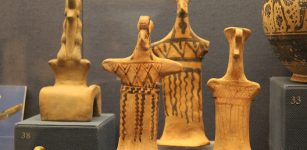 Mycenaean Culture Used Lignite For Their Kilns 3,000 Years Ago – Surprising Discovery Reveals
Archaeology | Jan 25, 2022
Mycenaean Culture Used Lignite For Their Kilns 3,000 Years Ago – Surprising Discovery Reveals
Archaeology | Jan 25, 2022 -
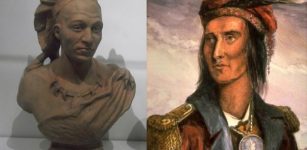 Tecumseh: Native American Mystic, Warrior, Hero And Military Leader Of The Shawnee
Featured Stories | Jun 3, 2016
Tecumseh: Native American Mystic, Warrior, Hero And Military Leader Of The Shawnee
Featured Stories | Jun 3, 2016 -
 Underwater Excavations: Greek And Danish Archaeologists Research Ancient Harbor Town Lechaion
Archaeology | Dec 25, 2015
Underwater Excavations: Greek And Danish Archaeologists Research Ancient Harbor Town Lechaion
Archaeology | Dec 25, 2015 -
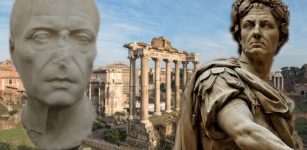 Cato The Younger – Mortal Enemy Of Julius Caesar Was A Man Who Hated Luxury, New Ideas And Was Immune To Bribes
Featured Stories | Apr 17, 2021
Cato The Younger – Mortal Enemy Of Julius Caesar Was A Man Who Hated Luxury, New Ideas And Was Immune To Bribes
Featured Stories | Apr 17, 2021 -
 Satellite Images Of 66 New Roman Army Sites Show More Clues About One Of The Empire’s Most Infamous Conflicts
Archaeology | Dec 23, 2020
Satellite Images Of 66 New Roman Army Sites Show More Clues About One Of The Empire’s Most Infamous Conflicts
Archaeology | Dec 23, 2020 -
 Infamous End Of Lugalzagesi – Ambitious King Who United Sumer
Featured Stories | Apr 30, 2020
Infamous End Of Lugalzagesi – Ambitious King Who United Sumer
Featured Stories | Apr 30, 2020 -
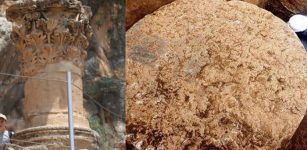 Massive Roman-Era Column Base Of Limestone Unearthed In The Foothills Of Mount Hermon, Golan Heights
Archaeology | Oct 29, 2022
Massive Roman-Era Column Base Of Limestone Unearthed In The Foothills Of Mount Hermon, Golan Heights
Archaeology | Oct 29, 2022 -
 Legend Of The Blue Men Of Minch: Were They Mythological Creatures Or Real Men?
Featured Stories | May 13, 2016
Legend Of The Blue Men Of Minch: Were They Mythological Creatures Or Real Men?
Featured Stories | May 13, 2016 -
 Vedic God Indra: Ruler Of Heavens And Tough Warrior Who Kills Evil Serpent Vritra
Featured Stories | Feb 1, 2019
Vedic God Indra: Ruler Of Heavens And Tough Warrior Who Kills Evil Serpent Vritra
Featured Stories | Feb 1, 2019 -
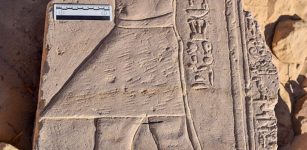 2nd Century Roman Temple Unearthed In Aswan, Egypt
Archaeology | Feb 23, 2018
2nd Century Roman Temple Unearthed In Aswan, Egypt
Archaeology | Feb 23, 2018 -
 Surprising DNA Study Links Present-Day Native American Tribe To Ancestors In San Francisco Bay Area
Archaeology | Mar 22, 2022
Surprising DNA Study Links Present-Day Native American Tribe To Ancestors In San Francisco Bay Area
Archaeology | Mar 22, 2022 -
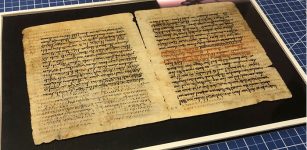 Lost Ancient Texts Of The Star Catalogue Composed By The Greek Astronomer Hipparchus Found
News | Feb 21, 2023
Lost Ancient Texts Of The Star Catalogue Composed By The Greek Astronomer Hipparchus Found
News | Feb 21, 2023 -
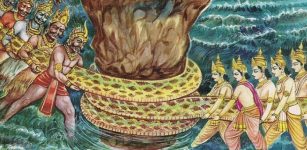 Churning Of The Ocean: Great Hindu Story Of Creation From Mahabharata And Purana
Featured Stories | Jun 16, 2018
Churning Of The Ocean: Great Hindu Story Of Creation From Mahabharata And Purana
Featured Stories | Jun 16, 2018 -
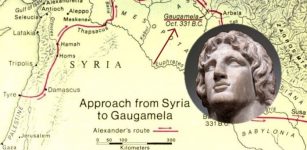 Why Is The Battle Of Gaugamela Called Broken ‘Camel’s Back’?
Ancient History Facts | Jul 1, 2020
Why Is The Battle Of Gaugamela Called Broken ‘Camel’s Back’?
Ancient History Facts | Jul 1, 2020 -
 Campus Mounds Are The Oldest Known Human-Made Structures In North America – New Research Shows
Archaeology | Aug 22, 2022
Campus Mounds Are The Oldest Known Human-Made Structures In North America – New Research Shows
Archaeology | Aug 22, 2022 -
 Lost City Of Alexander The Great Found After 2,000 Years In Iraq
Archaeology | Oct 1, 2017
Lost City Of Alexander The Great Found After 2,000 Years In Iraq
Archaeology | Oct 1, 2017 -
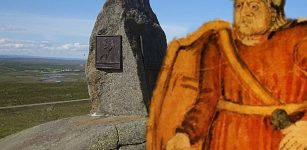 Why Was Grette The Strong, Icelandic Poet And Warrior Afraid Of Darkness?
Featured Stories | Sep 30, 2023
Why Was Grette The Strong, Icelandic Poet And Warrior Afraid Of Darkness?
Featured Stories | Sep 30, 2023 -
 Mysterious Nine Worlds Of Yggdrasil – The Sacred Tree Of Life In Norse Mythology
Featured Stories | Mar 8, 2017
Mysterious Nine Worlds Of Yggdrasil – The Sacred Tree Of Life In Norse Mythology
Featured Stories | Mar 8, 2017 -
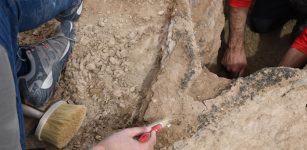 Unique, Well-Preserved 4,000-Year-Old Boat Discovered Near The Ancient City Of Uruk
Archaeology | Apr 4, 2022
Unique, Well-Preserved 4,000-Year-Old Boat Discovered Near The Ancient City Of Uruk
Archaeology | Apr 4, 2022 -
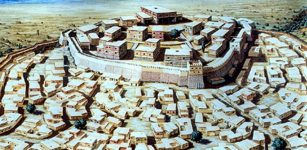 Achilles – Son Of King Peleus And Leader Of The Nereids
Featured Stories | Sep 3, 2015
Achilles – Son Of King Peleus And Leader Of The Nereids
Featured Stories | Sep 3, 2015

